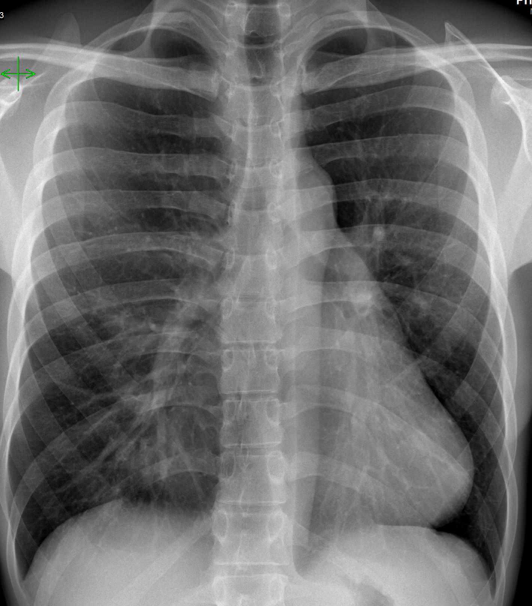
Dear Friends,
After a complicated case (Case 21: Heterotaxia) here is more straightforward one.
A young man with breathing difficulty when doing physical activity.

Let’s see what you think!
Click here for the answer

Congratulations to several of you who identified the case as Pectus Excavatum.
Obviously the lateral radiograph is the clue in this case where you can see a profound excavation of the anterior chest.
The most common features in pectus excavatum (as seen in this case)
- Blurring of the right heart border
- Increased density of lower right lung
- Horizontal posterior ribs
- Vertical anterior ribs
- Heart displaced to the left
Most common pitfalls in the diagnosis:
- Middle lobe consolidation or atelectasis ( Silhouette sign).
- Cardiac pathology
- Mediastinal mass
CT is used in severe cases to evaluate the possibility of surgical repair. Axial images provide excellent information regarding the AP diameter of the chest and the angle of the sternum.
In our case no need for treatment was decided.
Restrepo CS, Martinez S, Lemos DF et-al. Imaging appearances of the sternum and sternoclavicular joints. Radiographics. 29 (3): 839-59. doi:10.1148/rg.293055136 – Pubmed citation
Mitral valve disease
plain radiograph of the chest revealed:
– increased cardiothoracic ratio with left ventricular configuration,showing mitralized left cardiac border, denoting left atrial enlargement.
– prominent right cardiac border, consistent with right atrial enlargement
– bilateral prominent central and basal bronchopulmonary vasculature with increased vessel number(plethora), mostly represent shunt vascularity..
– clear lung shadow with no definite nodule or consolidative patches.
picture could suggest underlying congenital heart disease, mostly shunt pathology for echocardiographic assessment
Pectus excavatum
left forward shift of the mediastinum with blurring of right heart borders pectus excavatum
Pectus excavatum
Looks like pectus excavatum
Blurring of right heart border as well as horizontal posterior ribs and vertical anterior ribs.
Could be pectus excavatum
Pectum excavatum
Pectus excavatum, evident by:
– blurring of right heart border
– horizontal posterior and vertical
anterior ribs (7 & inverted 7 shape)
– displacement of Cardiac shadow
towards the left
Pectus excavatum
Purmonary trunk seems enlanged, finding compatible with pecuts excavatum.
Physical appearance information is warranted
Partial pericadial agenesia
Pectus excavatum